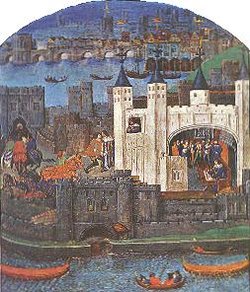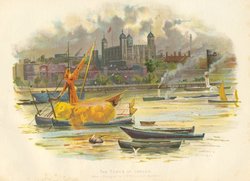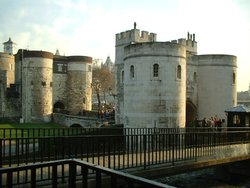Tower of London
|
|
Tower_of_London,_Traitors_Gate.jpg
The Tower of London is officially Her Majesty's Palace and Fortress, The Tower of London, although the last ruler to reside in it as a palace was King James I (1566-1625). The White Tower, the square building with turrets on each corner that gave it its name, is actually in the middle of a complex of several buildings along the River Thames in London, which have served as fortress, armoury, treasury, mint, palace, place of execution, public records office, observatory, refuge, and prison, particularly for upper class prisoners. This last use has led to the phrase "sent to the Tower" meaning "imprisoned." Elizabeth I was imprisoned for a time in the Tower during her sister Mary's reign; the last known use of the Tower as a prison was during World War II, for Rudolf Hess.
| Contents |
History
The first known fortification on the site was a Roman fortress that Claudius built to protect the city of Londinium.
In 1078 William the Conqueror ordered the White Tower to be built, as much to protect the Normans from the people of the City of London as to protect London from anyone else. Earlier forts there, including the Roman one, had primarily wooden buildings, but William ordered his tower to be of stone that he had specially imported from France. It was King Richard the Lionheart who had the moat dug around the surrounding wall and filled with water from the Thames. The moat was not very successful until Henry III employed a Dutch moat building technique. (It was drained in 1830, and human bones were in the refuse found at its bottom.)
A Royal Menagerie was established at the Tower in the 13th century, possibly as early as 1204 in the reign of King John, and possibly stocked with animals from an earlier menagerie started in 1125 by Henry I at his palace in Woodstock, near Oxford. Its year of origin is often stated as 1235, when Henry III received a wedding gift of three leopards (so recorded, although they may have been lions) from Frederick II, Holy Roman Emperor. In 1264 it was moved to the Bulwark, which was duly renamed the Lion Tower, near the main western entrance. It was opened as an occasional public spectacle in the reign of Elizabeth I. By 1804 the menagerie was regularly open to the public. This was where William Blake saw the tiger that inspired his poem. The menagerie's last director, Alfred Cops, who took over in 1822, found the collection in a dismal state, but restocked it and issued an illustrated scientific catalogue. Unfortunately for him, the menagerie was not to last. The new London Zoo was due to open in Regent's Park and, partly for commercial reasons and partly for animal welfare, the animals were moved to the zoo. The last of the animals left in 1835, and most of the Lion Tower was demolished soon after, although Lion Gate remains.
Although lower-class criminals were usually executed by hanging at one of the public execution sites outside the Tower, and several high-profile convicts, such as Thomas More, were publicly executed on Tower Hill, nobles (especially ladies) were sometimes beheaded privately on Tower Green, inside the complex, and then buried in the "Chapel Royal of St. Peter ad Vincula" (Latin for "in chains," making him an appropriate patron saint for prisoners) next to the Green. Some of the nobles who were executed outside the Tower are also buried in that chapel. (External link to Chapel webpage (http://www.camelotintl.com/tower_site/tower/chapel.html))
- Persons beheaded inside the Tower for treason:
The Queen Anne Boleyn, beheaded in 1536 for treason against King Henry VIII, is said to be seen walking around the tower carrying her head under her arm.
George, Duke of Clarence, the brother of Edward IV of England, was executed (for treason) in the Tower in February 1478, but not by beheading (and probably not by being drowned in a butt of Malmsey wine, despite what Shakespeare wrote). Edward IV's two sons, the Princes in the Tower, may also have died there after their uncle Richard III became king, but they were not executed for conviction of any crime, and what happened to them is still a mystery.
The military use of the Tower as a fortification, like that of other such castles, became obsolete with the introduction of artillery. However the Tower did serve as the headquarters of the Board of Ordnance until 1855, and the Tower was still occasionally used as a prison, even through both World Wars. In 1780, the Tower held its only American prisoner, former President of the Continental Congress, Henry Laurens. In World War I, 11 German spies were shot in the tower, and Corporal Josef Jakobs became the last German spy to be shot on August 15, 1941 during World War II. In the following year, Hitler's deputy, Rudolf Hess, was imprisoned for 4 days. Waterloo Barracks, the current location of the Crown Jewels, remained in use as a base for the 1st Battalion Royal Fusiliers (City of London Regiment) into the 1950s; during 1952 the Kray twins were briefly held here for failing to report for national service, making them among the last prisoners of the Tower; the last British citizen held for any length of time was the traitorous Army officer Norman Baillie-Stewart from 1933-1937.
Description
Tower_of_london_interior_bs.jpg
The Tower today is principally a tourist attraction. Besides the buildings themselves, the British Crown Jewels, a fine armour collection from the Royal Armouries, and a remnant of the wall of the Roman fortress are on display.
The tower is manned by the Yeomen Warders, who act as tour guides, provide discreet security and are something of a tourist attraction in their own right. Every evening, the warders participate in the Ceremony of the Keys, as the Tower is secured for the night.
In deference to an ancient legend, a number of ravens are fed at the Tower at government expense; so long as the ravens remain at the Tower, England is safe from invasion. The names of the seven ravens currently in the tower are Hardey, Thor, Odin, Gwyllum, Cedric, Hugin and Munin.
The Tower includes the following towers, listed in alphabetic order:
- Beauchamp Tower
- Bell Tower
- Bloody Tower
- Bowyer Tower
- Brick Tower
- Broad Arrow Tower
- Byward Tower
- Constable Tower
- Cradle Tower
- Develin Tower
- Deveraux Tower
- Flint Tower
- Lanthorn Tower
- Martin Tower
- Middle Tower
- St Thomas's Tower
- Salt Tower
- Wakefield Tower
- Wardrobe Tower
- Well Tower
- White Tower
Location

The Tower is located at the eastern boundary of the City of London financial district, adjacent to the River Thames and Tower Bridge. Between the river and the Tower is Tower Wharf, a freely accessible walkway with excellent views of the the river, tower and bridge, together with HMS Belfast and London City Hall on the opposite bank.
The nearest public transport locations are:
- Tower Hill tube station (London Underground District and Circle lines)
- Tower Gateway DLR station (Docklands Light Railway)
- Fenchurch Street railway station (National Rail)
- Tower Millennium Pier (river cruise boats)
See also
External links
- Tower-of-London.org.uk (http://www.tower-of-london.org.uk/webcode/tower_home.asp)
- London Pass: Tower of London (http://www.londonpass.com/ViewAttraction.asp?Id=48&CategoryId=2)
- Authorised Guide to the Tower of London (http://www.gutenberg.net/etext/13436) by W. J. Loftie, circa 1904, from Project Gutenberg
References
- Bennett, Edward Turner, The Tower Menagerie: Comprising the Natural History of the Animals Contained in that Establishment; with Anecdotes of their Characters and History, London, Robert Jennings, 1829da:Tower of London
de:Tower von London es:Torre de Londres he:מצודת לונדון fr:Tour de Londres ja:ロンドン塔 nl:Tower of London pl:Tower of London no:Tower of London sv:Towern zh:伦敦塔



